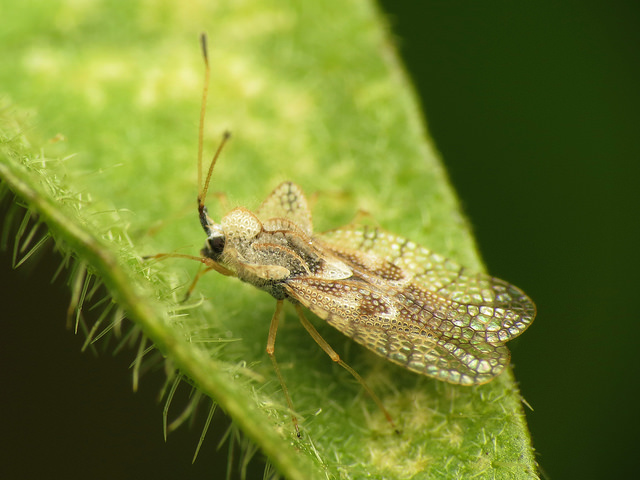Introduction
Lace bugs are a group of insects that belong to the family Tingidae. There are approximately 140 species of lace bugs in North America. Most lace bugs target a specific host. Some of the most common lace bug species are Stephanitis pyrioides, which infests azaleas, Corythucha cydoniae, which is partial to hawthorns, Teleonemia scrupulosa, which feeds on lantana, and Corythuca celtidis, which attacks hackberry. Lace bugs are generally considered a minor nuisance. Dense populations are capable of causing mild to moderate defoliation of host plants.
Distribution & Habitat
Lace bugs are widespread across North America. They can be found wherever susceptible plants are present. They are especially common in mild locations, where the adults can reproduce throughout most of the year
Hosts
Some of the most common lace bug hosts include alder, ash, avocado, azaleas, basswood, birch, buckeye, ceanothus, cherry, coyote brush, elm, fringetree, hackberry, hawthorn, lantana, London plane, photinia, poplar, rhododendrons, serviceberry, sycamore, toyon, walnut, and willow.
Description
Lace bugs vary from 1/8 to 3/8 of an inch in length. All lace bugs form an intricately structured dorsal surface and thorax. The thorax and forewings feature numerous transparent cells that resemble lace. This trait is characteristic to lace bugs, and distinguishes them from other insects. The adults and nymphs have slender, piercing mouthparts, which they utilize to penerate the foliage of their hosts. The nymphs are oval-shaped, and lack wings. They are pointed at the anterior and posterior. The nymphs are generally dark in coloration, and possess multiple spines. The eggs produced by the females are tiny, and oblong-shaped.
Life Cycle
All lace bug species produce three to six generations each year. In areas with mild climates, lace bugs will reproduce continuously throughout most of the year. In late spring, the adult females deposit around 300 eggs into the leaf tissue of their hosts. They subsequently cover them in a brown substance that hardens over, securing the eggs to the leaves. The eggs hatch within a few days, revealing masses of nymphs. The nymphs use their mouthparts to pierce the leaves, and consume their plant liquids. As they develop, the nymphs progress through five to six instars, rapidly increasing in size. They grow for 6 to 7 weeks before maturing into adults. Once mature, the adults mate. The females that have been fertilized lay eggs on the leaf tissue of the host, beginning the cycle anew.
Lace bugs can achieve maturation within 20 to 40 days. This allows for multiple generations to overlap, and feed together. The insects are most prevalent from late summer to fall, when their populations have boomed. If disturbed, the adults and nymphs will leap around repeatedly. They perform this action to dissuade predators.
Symptoms of Infestation
The adults and nymphs can be observed feeding on the underside of leaves. Due to their small stature, a magnifying lens may be required to see them clearly. As the insects feed, they cause a stippling of the infested leaves. The stippling initially appears as a series of tiny, white spots on the leaf surface. The spots quickly coalesce, resulting in extensive leaf discoloration. By mid-summer, the leaves will have turned yellow. By the end of the growing season, they will become necrotic.
As they feed, the adults and nymphs expel specks of dark excrement, which infested leaves can become laden with. When abundant, the excrement may drip onto surfaces located beneath the host. Severely infested plants may prematurely shed their leaves. Prior to dropping, the leaves will often wilt and curl. Avocados that experience premature leaf drop may incur sunburn damage, resulting in a significant reduction in fruit yield. Broad-leaved evergreens that are exposed to full sun may expire if heavily infested.
Management
- Begin inspecting vulnerable plants for lace bugs in late winter. Continue checking for lace bugs at least once a week throughout the growing season.
- Lace bugs do not often cause significant damage to their hosts. As such, most lace bug infestations can be tolerated, and offset by maintaining plants through sound cultural practices.
- Ensure that plants are sufficiently watered, especially during extended periods of drought.
- Apply a layer of organic mulch around vulnerable plants to improve the soil quality, moderate the soil temperature, and retain soil moisture.
- Stippled foliage should be promptly removed, and disposed of.
- When nymphs are abundant, they can be dislodged from plants with a strong stream of water. Direct the water at the underside of the leaves. Initiate this practice by late spring, and repeat it every 1 to 2 weeks to inhibit the growth of lace bug populations.
- Various insecticides may be employed to combat lace bug populations. Non-persistent, contact insecticides are recommended for use on lace bugs, as they are not as detrimental to beneficial insects. Begin applying insecticides by late spring. Continue to perform applications at three to four week intervals, until the growing season has ceased.
- When planting, select trees and shrubs that are suitable for the location. Plant susceptible trees and shrubs away from sidewalks and buildings. This will prevent the excrement produced by the lace bugs from accumulating on nearby surfaces. Replace or transplant trees or shrubs that are not thriving in a particular setting.
- Avoid exposing vulnerable plants to full sun, as it can render them more prone to infestation, and environmental injuries.
- Lace bug populations may be limited on various shrubs by removing mulch and leaf litter from beneath host plants during the winter months. Mulch can be replaced the following spring.
- In fall, rake and compost leaves that have been shed beneath plants infested by lace bugs.
- Lace bugs have a multitude of predators and parasites that help to suppress their populations. Some of the most effective include assassin bugs, lady beetles, lacewing larvae, jumping spiders, mites, and parasitic wasps.
- Horticultural oils can be sprayed on leaves to deter lace bug populations.
Photo courtesy of Katja Schulz CC-by-2.0


